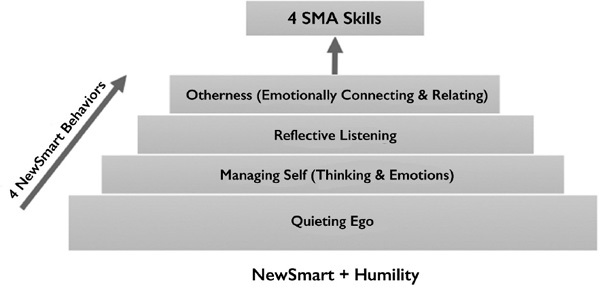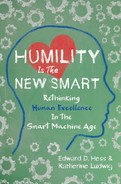Part 2
NewSmart Behaviors
In the next four chapters, we focus on “how to” perform four of the most foundational behaviors that underlie the SMA Skills: Quieting Ego, Managing Self, Reflective Listening, and Otherness. As we mentioned earlier, people are more inclined to change their behavior if they first change their personal mental model—their views of self and the world—in a manner that supports those new behaviors. In other words, beliefs drive behaviors, and we believe that accepting the NewSmart definition and the Humility mindset will enable you to embrace the NewSmart Behaviors that underlie the SMA Skills.
But good intentions are not enough. You must slow down and make daily, thoughtful choices and exert effort to engage in the behaviors that will allow you to develop the skills you’ll need to survive and thrive. Behaviors are measurable—and measuring yourself and holding yourself accountable are necessary for improvement. And to be good at any behavior, you must know what to do, understand how to do it, and have the motivation to do it. And you have to “do it” consistently in an excellent manner. The more you do that, the easier it becomes. Walter Mischel, a psychologist and the author of The Marshmallow Test: Mastering Self-Control, explains the reinforcing nature of practicing behaviors this way: “If we persist … the gratification that our new behavior produces will help sustain it: the new behavior itself becomes valued, no longer a burden but a source of satisfaction and self-confidence. As with all efforts to change long-standing patterns and learn new ones … the prescription is to ‘practice, practice, practice’ until it becomes automatic and intrinsically rewarding.”1
In these chapters we offer ideas, templates, processes, and tips gathered from science, our field research, our work with managers and leaders, and our own experiences and experiments in trying to improve our NewSmart Behaviors. And we discuss in detail how these behaviors, illustrated in the diagram below, build on as well as reinforce and interact with each other to help you perform the SMA Skills.

We settled on these particular behaviors by reverse engineering the four SMA Skills to determine the most fundamental common behaviors underlying them, based on researching hundreds of academic articles and over forty-five leading books about those four skills. Other behaviors are important, too, but we believe that these four behaviors are foundational. Another fundamental concept that we discuss in Part 2 is choice. In working through the content of this book in workshops and classrooms, it became apparent to us that many people don’t fully understand how much of our behavior as humans is a result of a choice. Too many times, we operate on autopilot or react or act reflexively without intention. For example, most of us have the choice to do the following throughout the day:
1. Think and behave with focus, deliberation, and intention or operate on autopilot
2. Be wholly present in the moment or let anxieties and rumination distract us
3. Respond to our fears and insecurities in a particular way
4. Listen to others with a nonjudgmental, quiet mind (or not)
5. Translate feelings into behaviors (or not)
6. Act defensively (or not)
7. Connect with people (or not)
Please take a moment and think about what other choices you would add to that list.
We believe that the choices we make—how we think, how we listen, how we manage our ego and fears, and how we connect and relate—will determine our ability to thrive in the SMA. In her wonderful book Positivity: Groundbreaking Research Reveals How to Embrace the Hidden Strength of Positive Emotions, Overcome Negativity, and Thrive, Barbara Fredrickson quotes this story from Cherokee folklore:
One evening an old Cherokee told his grandson about a battle that goes on inside us all. He said, “My son, the battle is between two wolves inside us all. One is Evil. It is anger, envy, jealousy, sorrow, regret, greed, arrogance, self-pity, guilt, resentment, inferiority, lies, false pride, superiority, and ego. The other is Good. It is joy, peace, love, hope, serenity, humility, kindness, benevolence, empathy, generosity, truth, compassion, and faith.” The grandson thought about it for a minute and then asked: “Which wolf wins?” The old Cherokee simply replied, “The one you feed.”2
We all have limited resources, both physical and psychological. If we expend most of our energy on being self-focused, protecting our egos, and trying to look smarter than everyone else in the room, then we won’t have enough energy to do the tough work of thinking critically and innovatively and focusing on and really listening to others, which we know is the key to better learning, thinking, and relating.
Although we discuss each of the four NewSmart Behaviors separately, they are not in fact distinct steps on the road to developing SMA Skills but are in many ways overlapping and mutually reinforcing. For example, Quieting Ego helps us manage our emotions and thinking and vice versa. Reflective Listening is both aided by and helps enable a quiet ego. Otherness—emotionally connecting and relating to others—requires and is made possible by Reflective Listening. That being said, we have found that for many people, these behaviors build on each other in the order presented in the diagram above. As such, in chapters 4–7 and in the NewSmart Behaviors Assessment in chapter 8, we address the behaviors in that order.
